Microlife Blood Pressure Monitor Manual: A Comprehensive Guide
Welcome to your comprehensive guide to the Microlife Blood Pressure Monitor Manual! This resource provides detailed information for users of Microlife blood pressure monitors. Find instructions, troubleshooting, and important safety information in this guide.
Microlife blood pressure monitors are digital devices designed for home or clinical use. They enable quick and reliable measurement of systolic and diastolic blood pressure and pulse rate using the oscillometric method. Microlife monitors are clinically tested, including for special patient groups like those with diabetes, renal disease, or during pregnancy. Many models feature advanced technologies like AFIBsens for atrial fibrillation detection. These monitors are user-friendly, accurate, and come with accessories such as cuffs, batteries, and instruction manuals, empowering individuals to manage their blood pressure effectively.
Understanding the Importance of Blood Pressure Monitoring
Regular blood pressure monitoring is crucial for maintaining cardiovascular health. High blood pressure, or hypertension, often has no symptoms but can significantly increase the risk of heart disease, stroke, and other serious conditions. Monitoring helps in early detection and management of hypertension. Microlife blood pressure monitors allow individuals to easily track their blood pressure at home, providing valuable data for healthcare providers. Early detection of hypertension can help prevent stroke or heart disease, so this makes regular monitoring very important for your health.
Overview of Microlife Blood Pressure Monitor Models
Microlife offers a range of blood pressure monitors designed to meet various needs. Models like the BP A200 provide basic, user-friendly monitoring with memory function and pulse rate measurement. The BP B3 Comfort PC is an oscillometric monitor suitable for individuals aged 12 and older. Some models, such as the BP3GY1-2N, offer premium features. Other models include Bluetooth connectivity for easy data transfer to smartphones or computers. Each model has its unique features and is designed for accurate and reliable blood pressure readings. They are all clinically tested for accuracy.
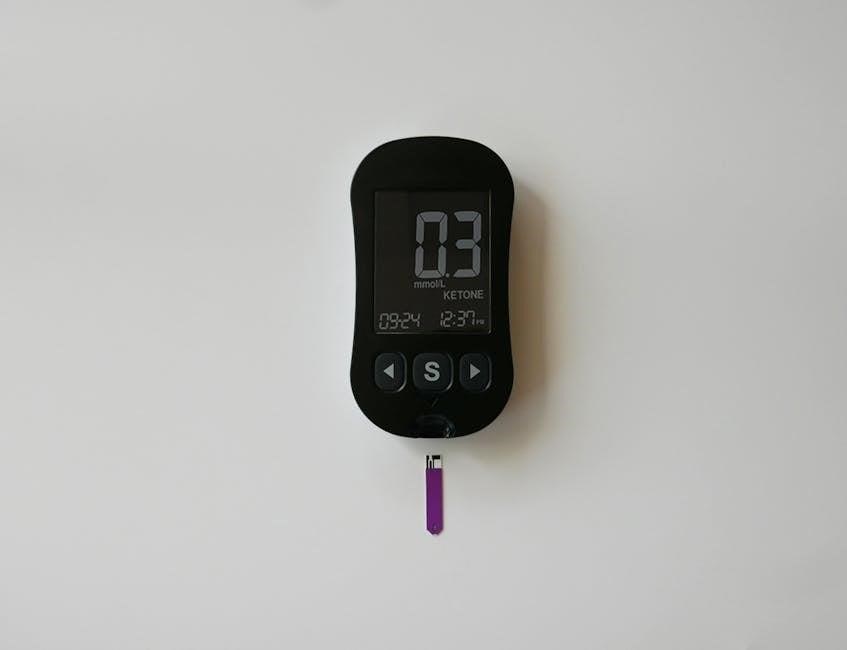
Key Features and Technologies
Microlife blood pressure monitors integrate advanced technologies for precise and convenient monitoring. Key features include AFIBsens for atrial fibrillation detection, oscillometric measurement, and Bluetooth connectivity for seamless data transfer and tracking.
AFIBsens Technology: Atrial Fibrillation Detection
Microlife’s AFIBsens technology is a leading feature in their blood pressure monitors, specifically designed to detect atrial fibrillation (AFib) during blood pressure measurement. AFib detection is crucial because early identification allows for timely medical intervention, reducing the risk of stroke and heart-related complications. This innovative technology analyzes pulse waves to identify irregular heart rhythms indicative of AFib; By incorporating AFIBsens, Microlife provides users with a valuable tool for proactive heart health management from the comfort of their homes, promoting early detection and improved patient outcomes. Regular monitoring is critical.
Oscillometric Measurement Method
Microlife blood pressure monitors employ the oscillometric measurement method to provide accurate and reliable blood pressure readings. This method works by detecting the oscillations in the arteries as the cuff inflates and deflates. These oscillations are converted into systolic and diastolic blood pressure values. The oscillometric method is widely used in automated blood pressure monitors due to its ease of use and accuracy. It doesn’t require a stethoscope, making it user-friendly for home monitoring. Microlife integrates advanced algorithms to ensure precise measurements, offering individuals a convenient way to monitor their cardiovascular health effectively. The technology ensures reliable results.
Bluetooth Connectivity and Data Transfer
Microlife blood pressure monitors offer seamless Bluetooth connectivity for easy data transfer. Users can sync their readings to smartphones or tablets using the Microlife Connected Health app. This feature allows for convenient tracking and monitoring of blood pressure trends over time. The app provides a comprehensive view of your data, enabling better management of your health. With Bluetooth connectivity, users can effortlessly share their readings with healthcare professionals, facilitating informed decision-making. The data transfer process is simple and secure, ensuring privacy and accuracy. Bluetooth connectivity enhances the overall user experience, making Microlife monitors a smart choice for modern health management.
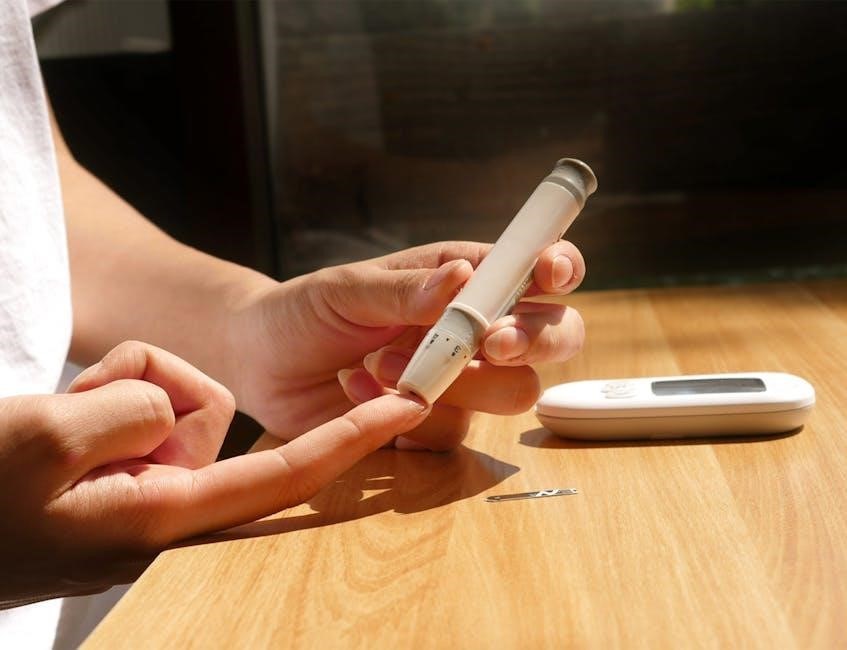
Using Your Microlife Blood Pressure Monitor
This section provides detailed instructions on how to effectively use your Microlife blood pressure monitor. Learn the correct setup, cuff placement, and body positioning for accurate blood pressure measurements every time.
Setting Up the Device for First Use
Before taking your first blood pressure measurement with your Microlife monitor, ensure proper setup. Begin by installing the included batteries, typically AA, into the designated compartment. Consult the device’s manual for the exact battery type and correct polarity. Next, connect the appropriate cuff size to the monitor, making sure the connection is secure. Familiarize yourself with the monitor’s display and buttons, referencing the manual for their specific functions. Finally, set the date and time on the device for accurate record-keeping of your blood pressure readings, following the instructions in your manual.
Proper Cuff Placement and Body Positioning
Accurate blood pressure readings depend on correct cuff placement and body positioning. Start by sitting comfortably in a chair with back support, ensuring your feet are flat on the floor and your legs are uncrossed. Position your arm on a table or surface at heart level. Apply the cuff to your bare upper arm, typically about one inch above the elbow. The artery mark on the cuff should align with your brachial artery. Ensure the cuff is snug but not too tight, allowing one finger to fit comfortably underneath. Remain still and quiet during the measurement process.
Taking a Measurement: Step-by-Step Guide
Follow these steps for accurate blood pressure readings with your Microlife monitor. First, ensure you have properly positioned the cuff and are seated comfortably. Power on the device by pressing the start button. The monitor will automatically inflate the cuff. Remain still and quiet during inflation and deflation. The display will show your systolic and diastolic blood pressure, along with your pulse rate. Record these values in your blood pressure diary. If an error occurs, consult the troubleshooting section of this guide. Repeat measurements as directed by your healthcare provider, waiting a few minutes between each reading.

Understanding the Display and Readings
This section helps you interpret your Microlife blood pressure monitor’s display. Learn about systolic and diastolic readings, pulse rate, and common error messages. Proper interpretation is crucial for effective monitoring.
Interpreting Systolic and Diastolic Blood Pressure
Understanding systolic and diastolic blood pressure readings is essential for monitoring your cardiovascular health using your Microlife device. Systolic pressure, the upper number, reflects the pressure when your heart beats. Diastolic pressure, the lower number, indicates the pressure when your heart rests between beats. High blood pressure, or hypertension, is typically defined as consistent readings above 130/80 mmHg. Regular monitoring and proper interpretation can help you manage your blood pressure effectively, especially when combined with your doctor’s advice and lifestyle adjustments, such as diet and exercise.
Understanding Pulse Rate Measurement
Your Microlife blood pressure monitor also measures your pulse rate, which is the number of times your heart beats per minute. A normal resting pulse rate typically falls between 60 and 100 beats per minute. Factors like stress, physical activity, and medication can influence your pulse. Consistently high or low pulse rates, especially when accompanied by other symptoms, should be discussed with your healthcare provider. Use your Microlife monitor to track changes in your pulse over time, providing valuable data for assessing your overall cardiovascular well-being and health.
Error Messages and Troubleshooting
Microlife blood pressure monitors display error messages to indicate problems during measurement. Common errors include cuff issues, movement during readings, or low battery. Refer to your manual to identify the specific error code. Ensure the cuff is properly placed and inflated. Remain still during measurements to avoid inaccurate readings. Replace batteries if the low battery indicator appears. If errors persist, consult the troubleshooting section in your manual or contact Microlife support for assistance. Addressing errors promptly ensures accurate and reliable blood pressure monitoring for effective health management.
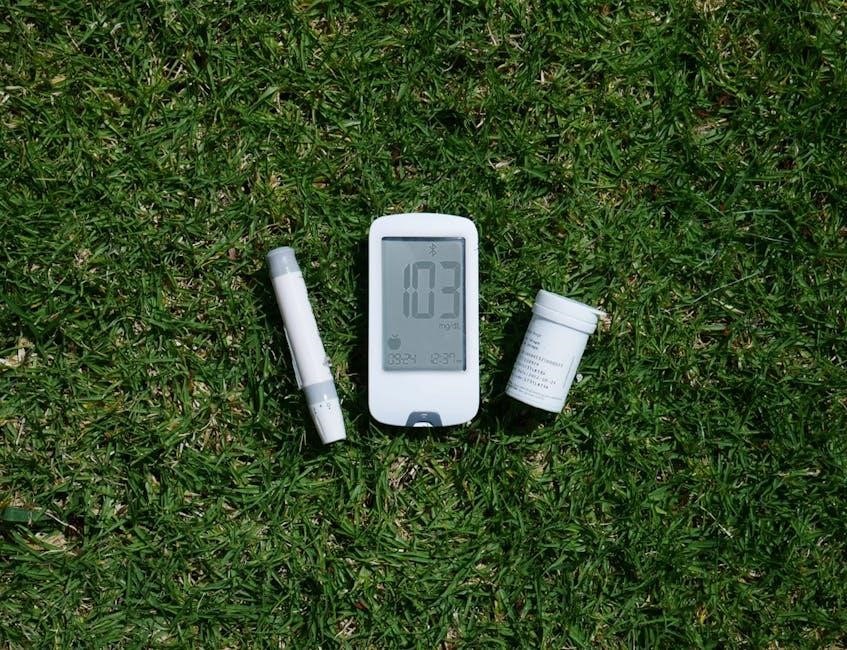
Maintenance and Care
Proper maintenance ensures accurate readings and prolongs your Microlife blood pressure monitor’s life. Regular cleaning, careful storage, and timely battery replacement are crucial. Follow the instructions in your manual for optimal performance and longevity.
Cleaning and Storing the Device
To maintain your Microlife blood pressure monitor, regular cleaning is essential. Use a soft, slightly damp cloth to wipe down the device and cuff. Avoid harsh chemicals or immersing the device in water, as this can damage the internal components. Proper storage is equally important; keep the monitor in a cool, dry place away from direct sunlight and extreme temperatures. When not in use, store the device and cuff in the provided storage bag to protect them from dust and damage. This ensures its accuracy and longevity for future blood pressure monitoring.
Battery Replacement Instructions
When your Microlife blood pressure monitor displays a low battery indicator, it’s time to replace the batteries. Open the battery compartment, usually located on the back of the device, and remove the old batteries. Insert new batteries, ensuring they are correctly aligned according to the polarity markings (+ and -) inside the compartment. Use the specified battery type as indicated in your monitor’s manual, typically AA or AAA alkaline batteries. Close the compartment securely. After replacement, the monitor may require a reset; consult the manual for specific instructions to ensure accurate readings with the new batteries.
Cuff Maintenance and Replacement
Proper cuff maintenance is crucial for accurate blood pressure readings. Regularly inspect the cuff for any signs of damage, such as tears, punctures, or leaks. Clean the cuff with a soft, damp cloth, avoiding harsh detergents or solvents that could degrade the material. Ensure the air tube is free from kinks or obstructions. If the cuff shows significant wear or damage, or if it no longer provides a snug fit, replace it with a compatible Microlife cuff. Refer to your device’s manual or a cuff size chart to select the correct size for accurate measurements and optimal performance.
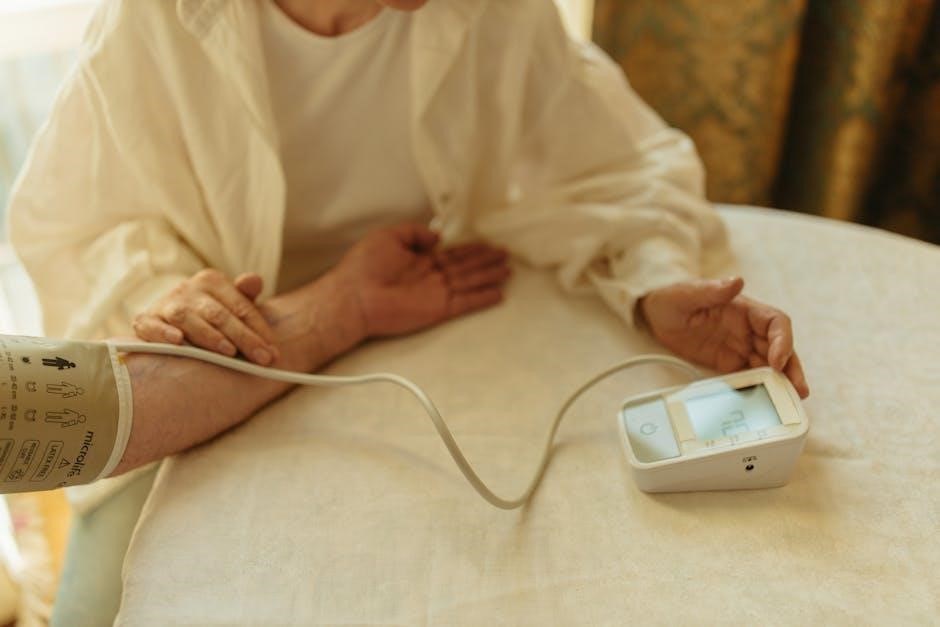
Troubleshooting Common Issues
Encountering problems with your Microlife blood pressure monitor? This section offers solutions for common issues. Find guidance on resolving connection problems, inaccurate readings, and power issues to ensure accurate monitoring.
Addressing Connection Problems
Experiencing difficulties connecting your Microlife blood pressure monitor to your smartphone or computer? Ensure Bluetooth is enabled on both devices. Check for compatibility issues between your monitor model and the receiving device. Try restarting both the monitor and the connected device. Verify that the Microlife app or software is up to date. Remove any obstructions that may interfere with the Bluetooth signal. Consult the manual for specific pairing instructions. If problems persist, contact Microlife support for further assistance in establishing a stable connection.
Dealing with Inaccurate Readings
If you’re encountering inconsistent or inaccurate blood pressure readings with your Microlife monitor, several factors could be at play. Ensure proper cuff placement and body positioning during measurements. Avoid movement or talking while the device is operating. Check the battery level, as low power can affect accuracy. Make sure the cuff size is appropriate for your arm circumference. Refrain from consuming caffeine or exercising 30 minutes prior to taking a reading. Repeat the measurement following the outlined procedures. Consult a healthcare professional if inaccuracies persist.
Solving Power Issues
Experiencing power problems with your Microlife blood pressure monitor can be frustrating. First, verify that the batteries are correctly installed, matching the polarity markings inside the battery compartment. Replace the batteries with new ones to ensure sufficient power, especially if the display is dim or the device fails to turn on. If using an AC adapter, check the connection to both the monitor and the power outlet. Ensure the adapter is the correct type for your model. If issues persist, contact Microlife support for assistance.
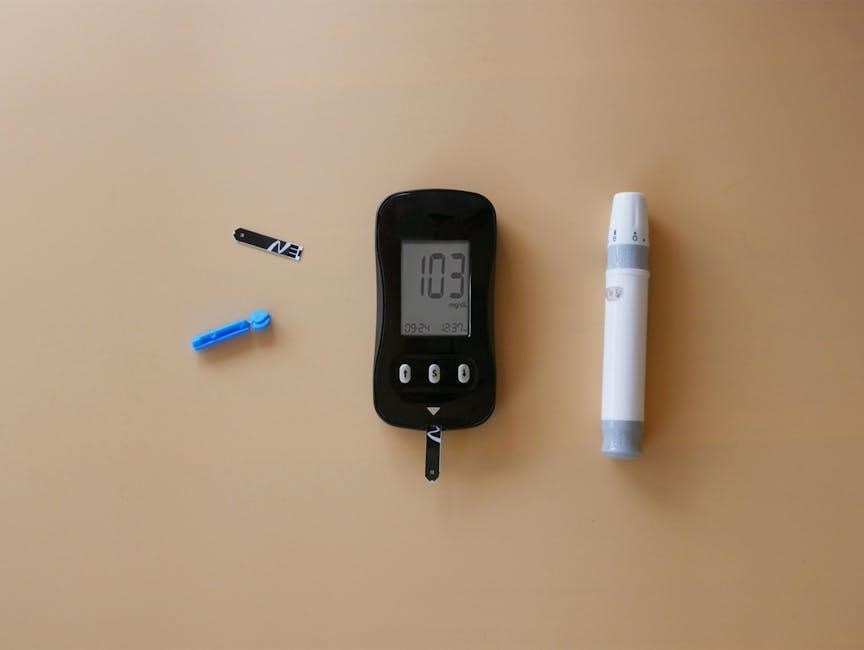
Available Manuals and Resources
Find instruction manuals for your Microlife blood pressure monitor model. Download cuff size charts and accessory manuals. Access PDF versions of manuals for easy reference and troubleshooting assistance.
Finding the Correct Manual for Your Model
Locating the appropriate manual for your specific Microlife blood pressure monitor is crucial for accurate usage and understanding of its features. Microlife offers a variety of models, each with its unique functionalities and operating instructions. To ensure you have the correct information, identify the model number printed on your device. Once you have this number, you can navigate the Microlife website or our resource list to find the corresponding manual. Having the right manual guarantees proper setup, measurement, and troubleshooting guidance tailored to your device.
Downloading Manuals in PDF Format
Accessing your Microlife blood pressure monitor manual in PDF format is a convenient way to have the information readily available on your devices. PDF manuals can be easily downloaded from the Microlife website or through authorized online resources. These digital manuals offer a user-friendly experience, allowing you to search for specific topics, zoom in on diagrams, and print pages as needed. Downloading the PDF version ensures you can access the instructions even without an internet connection, making it a practical solution for home use and travel. Keep your manual handy for optimal device operation.
Accessing Cuff Size Charts and Accessory Manuals
Ensuring accurate blood pressure readings requires the correct cuff size. Microlife provides cuff size charts to help you select the appropriate cuff for your arm circumference. These charts are often available alongside the main product manuals on the Microlife website. Additionally, accessory manuals, which detail the proper use and care of compatible accessories, can also be found online. Accessing these resources is crucial for maximizing the effectiveness of your Microlife blood pressure monitor. Refer to the cuff size charts and accessory manuals to optimize the performance and longevity of your device and its components.
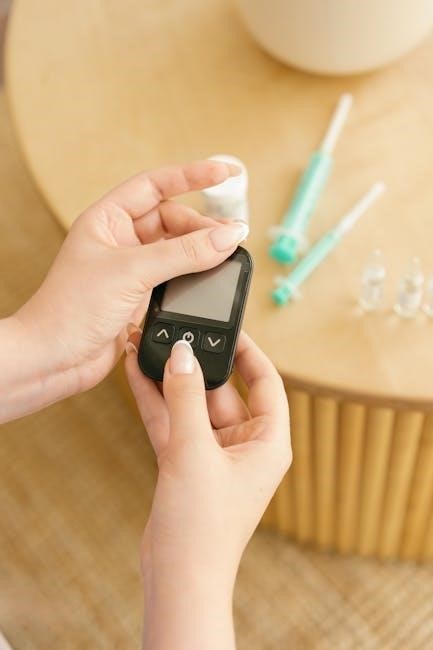
Clinical Validation and Accuracy
Microlife blood pressure monitors undergo clinical testing to ensure accuracy. These tests often include special patient groups, such as individuals with diabetes. Accuracy is validated against recognized standards to ensure reliable readings.
Clinical Testing for Special Patient Groups
Microlife blood pressure monitors undergo rigorous clinical testing to ensure accuracy and reliability across diverse patient populations. These special groups include individuals with diabetes, end-stage renal disease, pregnant women (including those with pre-eclampsia), and those experiencing hypotension. Clinical validation also extends to children from age 13. These tests are essential to guarantee the monitors deliver precise readings for those with specific health conditions. Such comprehensive testing assures users and healthcare professionals of the device’s dependability, contributing to better health management.
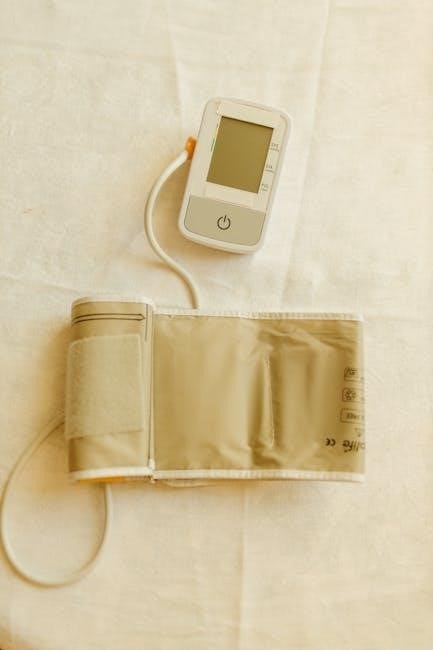
Accuracy According to British and Irish Hypertension Society (BIHS) Standards
Microlife blood pressure monitors achieve high accuracy and meet the rigorous standards set by the British and Irish Hypertension Society (BIHS). These monitors have undergone clinical validation, earning a clinical A/A grade according to BIHS protocols. This designation signifies excellent performance in both systolic and diastolic blood pressure measurements. Achieving this standard ensures that the monitors offer reliable and precise readings, crucial for effective blood pressure management and contributing to informed healthcare decisions. Users can trust these devices to provide dependable data;

Warranty and Support
Microlife blood pressure monitors come with a warranty, typically covering a period of two years from the purchase date. Contact Microlife support for assistance with warranty claims, troubleshooting, or any other product-related inquiries you may have.
Warranty Period and Coverage
Microlife blood pressure monitors are generally guaranteed for two years from the original purchase date. This warranty typically covers defects in materials and workmanship, ensuring your device functions correctly. The warranty may not cover damages caused by misuse, accidents, or unauthorized repairs. It’s essential to keep your proof of purchase for warranty claims. Refer to the specific warranty card included with your monitor for complete details regarding the coverage and any exclusions that may apply to your specific model.
Contacting Microlife Support for Assistance
If you encounter issues with your Microlife blood pressure monitor that you cannot resolve using the troubleshooting section of the manual, contacting Microlife support is a good option. You can usually find contact information, including phone numbers and email addresses, on the Microlife website or within the product documentation. Be prepared to provide your model number, purchase date, and a detailed description of the problem you are experiencing when reaching out to them. They may be able to offer specific guidance or arrange for repairs or replacements if covered under warranty.



